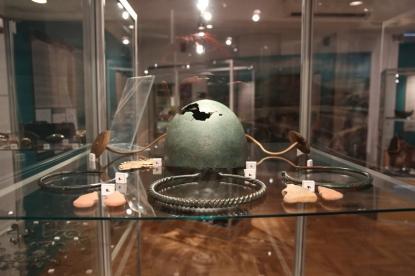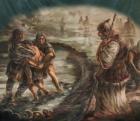2024. April 27. Saturday
Ottó Herman Museum Exhibition Building - Miskolc
|
|
Address: 3530, Miskolc Papszer utca 1.
Phone number: (46) 346-875
E-mail: latogato@hermuz.hu
Opening hours: Temporarily closed.
|
The exhibition has closed for visitors.
2015.10.13. - 2016.06.12.
Museum tickets, service costs:
|
Group ticket
(up to 20 people)
|
3000 HUF
|
|
|
Group ticket
(21-35 people)
|
4500 HUF
|
|
|
Ticket for adults
|
600 HUF
|
|
|
Ticket for students
|
300 HUF
|
|
|
Ticket for pensioners
|
300 HUF
|
The bilingual exhibition presents the latest results of early / middle and late Bronze Age related researches in Borsod-Abaúj-Zemplén County focusing on the world of our ancestors who lived in Northeast Hungary in the period 2300 to 900 BC. The exhibition addresses the mysteries from several aspects including modern research methods applied by the Herman Ottó Museum at a number of sites, as well as various possibilities for interpretation. As the exhibition title anticipates, the visitors are invited to take part in an exciting time travel where both in space and time, they together with the archaeologists may discuss the differences between human. The Other / World encourages visitors to reconsider what they have thought about our ancestors, their rituals and beliefs systems.

In the first part of the exhibition we invite the visitors to come with is into the early / middle Bronze Age cultures (approx. 2300-1400 BC). The word tell is of Arab origins meaning hill. European archaeologists describe artificial mounds with this word that emerged due to the fact that generation to generation had their settlements in the same, one after another. The hills were formed as the result of human activities over time: the collapsed (or deliberately destroyed) buildings, remnants cumulated one upon another, resulting in constantly rising, layered mounds.
In the second part of the exhibition, visitors literally finds themselves in an "other world", the closed microcosm resulted by strict rules of the middle Bronze Age disappear, leaving room for the Late Bronze Age (approx. 1400-900 BC). This part of the exhibition is a tribute to the period before the first explosion of globalization in which the space opened up across Europe, resulting in increasing cultural relations, human communities becoming more mobile and the objects increasingly more universal.. Late Bronze Age communities previously took possession of untapped ecological zones, their settlement system reflected a rather a hierarchical society. Hillforts were built on hilltops but more and more homestead like settlements appeared. The emphasis shifted toward agriculture as well as more intensive farming and animal husbandry. Novel technologies were introduced such as ceramic or metallurgy. Polished surface burnt ceramics imitating metal container in two colours of burnt were invented , bronze objects were made by more sophisticated techniques.

In the first part of the exhibition we invite the visitors to come with is into the early / middle Bronze Age cultures (approx. 2300-1400 BC). The word tell is of Arab origins meaning hill. European archaeologists describe artificial mounds with this word that emerged due to the fact that generation to generation had their settlements in the same, one after another. The hills were formed as the result of human activities over time: the collapsed (or deliberately destroyed) buildings, remnants cumulated one upon another, resulting in constantly rising, layered mounds.
In the second part of the exhibition, visitors literally finds themselves in an "other world", the closed microcosm resulted by strict rules of the middle Bronze Age disappear, leaving room for the Late Bronze Age (approx. 1400-900 BC). This part of the exhibition is a tribute to the period before the first explosion of globalization in which the space opened up across Europe, resulting in increasing cultural relations, human communities becoming more mobile and the objects increasingly more universal.. Late Bronze Age communities previously took possession of untapped ecological zones, their settlement system reflected a rather a hierarchical society. Hillforts were built on hilltops but more and more homestead like settlements appeared. The emphasis shifted toward agriculture as well as more intensive farming and animal husbandry. Novel technologies were introduced such as ceramic or metallurgy. Polished surface burnt ceramics imitating metal container in two colours of burnt were invented , bronze objects were made by more sophisticated techniques.

